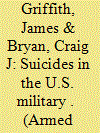|
|
|
Sort Order |
|
|
|
Items / Page
|
|
|
|
|
|
|
| Srl | Item |
| 1 |
ID:
153625


|
|
|
|
|
| Summary/Abstract |
Despite increasing prevention efforts, military suicide rates have surpassed those of the general population. This trend may reflect a deficit in our understanding of suicide, historically atheoretical and based on decreasing risk factors of suicide. The interpersonal–psychological theory of suicide (IPTS) provides a theoretical foundation to understand suicide but only assesses three risk factors of suicide and is primarily aimed at explaining who may die by suicide, but not when. The fluid vulnerability theory (FVT) provides a broad theoretical framework to understand and organize risk and protective factors of suicide in order to understand the process of suicide risk over time. Overlaying the IPTS’s constructs of thwarted belongingness, perceived burdensomeness, and the acquired capability for suicide within the FVT framework provides a robust model to understand not only who is at risk for suicide but also when suicide risk is likely to emerge.
|
|
|
|
|
|
|
|
|
|
|
|
|
|
|
|
| 2 |
ID:
173119


|
|
|
|
|
| Summary/Abstract |
U.S. National Guard (NG) military personnel experience many barriers to care such as limited access to health-care services and geographic separation from service providers. Although stigma and barriers to mental health care have been examined in the military, little is known about how different facets of stigma and barriers to care might impact different military subgroups. In a sample of 965 NG personnel, latent class analysis was used to identify distinct subgroups of stigma and barriers to care. Four groups were identified: no stigma or barriers (31%), mild stigma and barriers (30%), high stigma and career concerns (20%), and moderate stigma and barriers (20%). Classes significantly differed with respect to several demographic characteristics, rates of mental health conditions, and rates of previous suicidal thoughts and behaviors. Results suggest that different subgroups of NG personnel vary with respect to levels of perceived stigma, barriers to care, and mental health needs.
|
|
|
|
|
|
|
|
|
|
|
|
|
|
|
|
| 3 |
ID:
146880


|
|
|
|
|
| Summary/Abstract |
This paper builds a case for examining suicide in the U.S. military relative to broad societal context, specifically, the unique experiences of birth cohorts relating to processes described by Durkheim’s theory of suicide. In more recent birth cohorts, suicide rates have increased among teenagers and young adults. In addition, suicide rates of age intervals at a given time period have been reliably predicted by the size of the birth cohort and the percentage of nonmarital births—supposed indicators of Durkheim’s diminished social integration and behavioral regulation. Consequences of these trends are likely more evident in the U.S. military due to having proportionally more individuals known to be at risk for suicide, that is, young males who are from nontraditional households. The all-volunteer force compared to draft force has fewer applicants to select, and proportionally more of applicants are accepted for military service. Consequently, more recruits having varied conditions now than before, perhaps including greater vulnerability to suicide, serve in the U.S. military. These points are further elaborated with supporting evidence, concluding with a call for new directions in suicide research, practice, and policy.
|
|
|
|
|
|
|
|
|
|
|
|
|
|
|
|
|
|
|
|
|